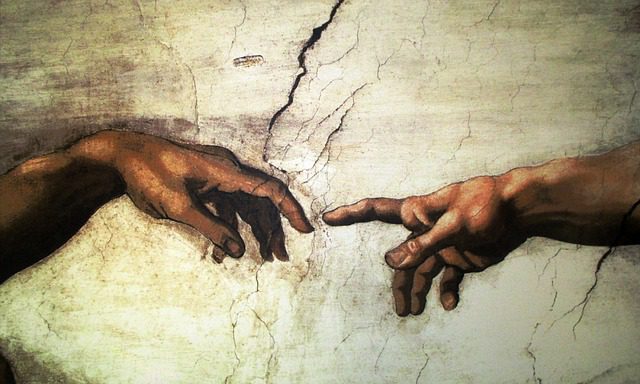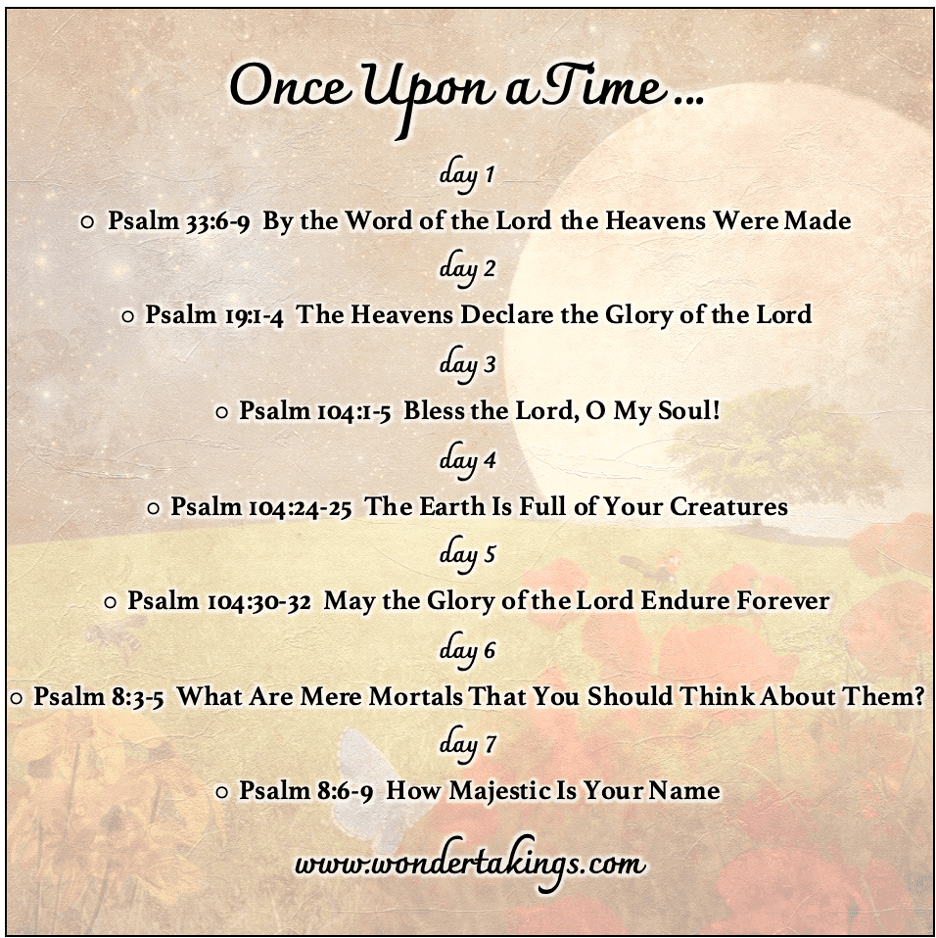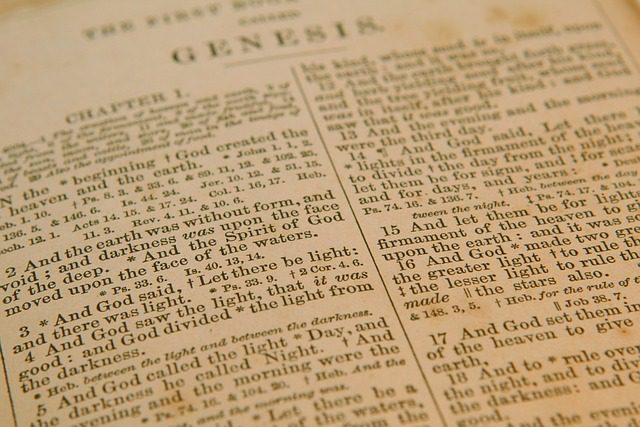Once Upon a Time…
“In the beginning God created the heavens and the earth.”
Genesis 1:1 NIV

“Stories have captivated humans since the dawn of creation . . . . God begins telling us His story with the words, ‘In the beginning’ (Genesis 1:1). From the moment Adam and Eve first drew breath (v. 27), God has used that unfolding story to shape not just our individual lives but also — and perhaps more importantly — our collective lives as His children.”
Kirsten Holmberg, “Beating as One”
Last week I introduced our plan for 2023 to journey through The NeverEnding Story of the Bible and discover how we fit into it along the way. This week, we begin with the story of creation in Genesis 1. Our plan for this year is loosely based on The Story, an abridged chronological version of the Bible, and the accompanying study guide The Heart of the Story by Randy Frazee. Here is the overview I posted last week, which lists the chapters in The Story along with the accompanying Scripture texts:
I also have several other books I will use for additional insights. One of them is The Bible Recap by Tara-Leigh Cobble. In it, she discusses three primary mistakes she made that held her back from understanding and loving Scripture. I think they are mistakes we are all prone to make, so I want to mention them before we get started:
- Mistake #1: Looking for yourself instead of looking for God – We must read Scripture as a story about God and focus on what it reveals about Him, rather than thinking of the Bible as a to-do list or a means to self-help.
- Mistake #2: Hovering over the same passages of Scripture and disregarding the rest – Failing to understand the overall story of the Bible makes it hard to understand and impossible to love. The Bible is made up of 66 individual books from different vantage points and styles, but together they tell one story about God and the unshakeable love He has for His people.
- Mistake #3: Drawing conclusions about God before you’ve read the whole Bible – We won’t always find quick answers, and we can’t build a theology around one verse without considering the context. God is patient and reveals His truth to us in baby steps. We must, therefore, be patient and let Him guide us in understanding little by little each day.
As we dive in to God’s Word, we must be willing to let go of our own ideas of what we hope to find there and be swept away by the awe-inspiring story of God. God’s story is all about Him and the love He has for us. It takes courage to read His Word like this. What we discover will often shake us up and challenge our ideas, but ultimately it will lead us to find our true selves. It’s an adventure that’s not for the faint-hearted, but it’s the only way to really live. So, if you’re ready, let’s begin!
“If your first concern is to look after yourself, you’ll never find yourself. But if you forget about yourself and look to me, you’ll find both yourself and me.”
Matthew 10:39 MSG
Origin Stories

“The role of origin stories . . . is to enlighten the present by recalling the past.”
Rachel Held Evan, Inspired
In order to understand the Bible, we must understand the way it was written. The Bible is an anthology of 66 books written by many different authors in a variety of genres — narrative, history, poetry, proverb, prophecy, and allegory, just to name a few — but together they tell one grand story. How is this possible? Because the Holy Spirit was the ultimate editor. He inspired all those involved in the process, from the very first stories passed down through oral tradition to the final selection of writings chosen to make up the Bible. So we can trust that what we read comes from God. But we must recognize that not every book is written in the same literary form. According to the Literary Study Bible, paying attention to form is necessary for understanding anything we read:
“The foundational premise of all verbal communication is that meaning is conveyed through form, starting with language itself but moving beyond that to a whole range of literary forms and genres. There is no meaning without the form in which a piece of writing is expressed. This means that when we read the Bible, literary considerations are not optional features to which we might attend only if we have an interest in literary matters. We need to pay attention to the how of a Bible passage as preliminary to understanding what is said.”
Literary Study Bible
The stories we read in the first few chapters of Genesis are origin stories. According to Rachel Held Evans, Israel’s origin stories were not historical accounts designed to answer modern scientific questions. Rather, they were meant to answer ancient questions about God and His relationship to His creation. We shouldn’t read these origin stories in the same way we would read a historical narrative or a scientific paper. God spoke to these ancient people in a way they would understand, using the language and the literary forms known to them in the ancient world.
“Israel shared a conceptual world with its neighbors and used similar literary genres and stories to address issues of identity and purpose. . . . You don’t have to be a biblical scholar to recognize these genre categories for what they are. In the same way we automatically adjust our expectations when a story begins with ‘Once upon a time’ versus ‘The Associated Press is reporting . . . ,’ we instinctively sense upon reading the stories of Adam and Eve and Noah’s ark that these tales of origin aren’t meant to be straightforward recitations of historical fact. . . . the Spirit spoke the language of stories, quickening the memories of prophets and the pens of scribes to call a lost and searching people to gather together and remember . . . .”
Rachel Held Evans, Inspired
The main purpose of these origin stories was to recall Israel’s identity as a people chosen by God. God wanted them to understand the big picture of who He is and who they are. The same is true for us as we read these stories. What we need to know is this: In the beginning, God created all there is, and He declared it to be good. He created us to live in communion with Him, but we chose to turn away from Him, which caused sin, hardship, pain, and death to enter the world. But God did not give up on us. He made a way for His people to be reunited with Him forever. And He came up with a plan to restore His creation to the perfection He intended.
“It is no more beneath God to speak to us using poetry, proverb, letters, and legend than it is for a mother to read storybooks to her daughter at bedtime. This is who God is. This is what God does.”
Rachel Held Evans, Inspired
The Upper Story and the Lower Story

“God wants us to read the Bible as we would view a mural. The individual stories on its pages are connected, all entwining to communicate one overarching epic.”
Randy Frazee, The Heart of the Story
Randy Frazee talks about the Bible consisting of an Upper Story and a Lower Story, and to better understand what the Bible says, we must keep both perspectives in mind. The Lower Story is full of the everyday struggles and experiences of life on earth. It shows how God intervenes in individuals’ lives to offer wisdom, guidance, healing, and comfort. It’s zooming in to see God’s hand in the details of each individual story in the Bible and in our lives today. The picture above shows the ceiling of the Sistine Chapel in Rome. If we look at each of the individual paintings, we see God’s work in each of the Lower Stories depicted. However, if we focus instead on the overall panorama above us, and see how each individual painting fits together to create something much bigger, we begin to see the Upper Story.
“When we look up at the ceiling of the Sistine Chapel, it gives us hints that the Bible isn’t filled with a thousand individual stories of God’s intervention just to get people through rough times, but rather one grand story of something larger, something eternal. This is the Upper Story. . . . When we look at the Upper Story of God — his magnificent mural — we discover where we fit in, because this story was created to deliver one singular message: ‘If you want to live life to the fullest and enjoy it forever, then become part of my masterpiece.'”
Randy Frazee, The Heart of the Story
Randy Frazee explains that God’s story unfolds in a circular fashion, ending where it began in a beautiful garden. He discusses five movements within God’s story which lead us back to the restoration of God’s initial vision:
- MOVEMENT ONE: The Story of the Garden
- The Story: Chapter 1
- Genesis 1-11
- MOVEMENT TWO: The Story of Israel
- The Story: Chapters 2-21
- Genesis 12-Malachi
- MOVEMENT THREE: The Story of Jesus
- The Story: Chapters 22-27
- Matthew-John
- MOVEMENT FOUR: The Story of the Church
- The Story: Chapters 28-30
- Acts-Jude
- MOVEMENT FIVE: The Story of a New Garden
- The Story: Chapter 31
- Revelation
Notice that God’s story is still unfolding today. As Frazee says, “It is with the story of the church that we find ourselves as characters in this divine epic.” As we read God’s Word, we are reminded of what God has done and how God works in people’s lives. We also begin to see the big picture of God’s ultimate plan and how we fit into it. God is still painting His grand masterpiece. The more we know and understand God’s story, the more we begin to see our place in it. And the more overwhelmed we become at God’s great love for us.
“Like your own story, each of these stories will be unique, filled with drama, heartache, and joy. Taken individually, not all of them may make sense, but when viewed from God’s Upper Story, they fit together perfectly.”
Randy Frazee, The Heart of the Story
Creation: The Beginning of Life as We Know It

“‘In the beginning’ God came up with a plan to perfectly connect his Upper Story with our Lower Story.”
Randy Frazee, The Heart of the Story
Chapter 1 of The Story is titled “Creation: The Beginning of Life as We Know It” and covers Genesis 1-4, 6-9. This week we will just focus on the creation story in Genesis 1:
“The great drama of the beginning of all things starts with God. The language is simple but vivid. It evokes the wonder and richness of creation from formlessness to teeming life. More than this, it offers us the key to understanding ourselves and the world around us. The story, styled and shaped to a conscious pattern, makes it clear that
- the origin of the world and of life was no accident; there is a Creator — God;
- God made everything there is;
- all that God made was good;
- of all God’s marvellous creation, people are special: they alone are made in God’s ‘likeness’ and given charge over everything;
- God’s six ‘days’ of creative activity, followed by a ‘day’ of rest, sets the pattern for working life.
. . . We are not told when creation took place. Nor are we given details as to how God brought the earth and life into being — nor how long it all took. The storyteller does not share the preoccupations of a scientific age. He is concerned with more important things.”
Zondervan Handbook to the Bible
I did a couple of posts back in 2020, titled In the Beginning… and 6 Days = 13.8 Billion Years?, which discuss theories of how science fits with the creation account. But as mentioned above, the origin stories in Genesis are not meant to be read as historical narratives or scientific reports. So, while it’s fun to investigate the how of creation, doing so should never detract from the Creator Himself or the story He wants to tell us.
“Genesis, the first book in the story of God’s interactions with and plan for mankind, provides us with an amazing starting point. The first two chapters of this book — familiar to most of us — describe how God created the heavens and the earth, and all that is contained within them. But creation is only the subplot of this book. The real point of Genesis is so amazing it’s almost unbelievable: God wants to be with us. The God of the universe has created a place to come down and be with a community of people.”
Randy Frazee, The Heart of the Story
The origin stories in Genesis are not “The Associated Press is reporting” stories. They are “Once upon a time” stories. So to capture this feeling, I want to share the familiar Genesis 1 account in a different way. Here is the first part of the creation story as told in a children’s Bible:
“How the World Was Made”
“Long, long ago there was no world at all. There was no sun to shine, no stars to twinkle, no moonbeams to play through the night shadows. But even then there was God; for he has always been the same unchanging God.
Then, at the beginning of time, God made the world. At first water covered everything, and darkness was everywhere. What a strange, unfriendly world this must have been! But God planned to make it beautiful, so he said, ‘Let there be light.’ He called the light Day and the darkness he called Night. This was the first day of time. . . .”
~Egermeier’s Bible Story Book
As we read about God’s creation of the universe and everything in it, we should always keep in mind that the main purpose of this story is not to answer our scientific questions but to tell us something about God: God made everything there is and God wants to be with us because He loves us.
“While Scripture is 100 percent true, it isn’t always 100 percent literal. It’s important to hold our scientific conclusions or opinions with an open hand. It’s even important to hold our questions with an open hand, because this book isn’t necessarily here to answer them; it’s here to reveal GOD.”
Tara-Leigh Cobble, The Bible Recap
The Power of God’s Word

“And the earth was without form, and void; and darkness was upon the face of the deep. And the Spirit of God moved upon the face of the waters.
Genesis 1:2-3 KJV
And God said, Let there be light: and there was light.”
Before we conclude, there is one more thing I would like to mention about Genesis 1, and that’s the power of God’s Word. Notice in the Genesis account how God created everything — light, sky, land, seas, plants, sun, moon, stars, animals, and humans. He did so by merely speaking them into existence. “And God said . . .” is a recurring phrase in Genesis 1. Now, how literally we should take this, I don’t know, but I think the point God is making here is that His Word is very powerful! I think it’s a reminder that when God’s Word is sent out into the universe, amazing things happen. And we are invited to be a part of that.
Kirsten Holmberg talks about something amazing that happens when a group of people hear the same story at the same time: Research indicates that our hearts beat at the same rhythm as we listen. How cool is that! So, the message I think God is trying to convey here is “Go and tell my story!” Because if God’s Word has the power to bring the universe into existence, imagine what else it can do as we share it with others.
“Through the Bible — the most magnificent nonfiction story ever recorded — our hearts as believers in Jesus are joined together as people set apart for His purposes . . . . In response, may our hearts beat in shared rhythm, delighted by the Author’s creative works. And may we share His story with others, declaring ‘his glory among the nations, his marvelous deeds among all peoples’ (Psalm 96:3), inviting them to become part of it too.”
Kirsten Holmberg, “Beating as One”
This week’s Scripture passages are all psalms of praise for God and His creation. This week we began our journey into God’s eternal story with Genesis 1. Next week, we will continue our discussion of the origin stories by discussing Genesis 2-4, 6-9. We will also look at the book of Job.
Once upon a time, God spoke and the universe came into existence. He created everything there is, and He did so to be with us. Hearing God’s story has the power to unite and transform us, so He calls us to share it with others. As an inspiring example of this, I have included a video at the end of this post of the 1968 Christmas Eve broadcast by the Apollo 8 astronauts. May it inspire us to keep sending God’s Word out into the universe and see what He brings forth as a result!

“On Christmas Eve 1968, the Apollo 8 astronauts — Frank Borman, Jim Lovell, and Bill Anders — became the first humans to enter lunar orbit. As they circled the moon ten times, they shared images of the moon and the Earth. During a live broadcast, they took turns reading from Genesis 1. At the fortieth anniversary celebration, Borman said, ‘We were told that on Christmas Eve we would have the largest audience that had ever listened to a human voice. And the only instructions that we got from NASA was to do something appropriate.’ The Bible verses spoken by the Apollo 8 astronauts still plant seeds of truth into the listening hearts of people who hear the historical recording.”
Xochitl Dixon, “The Power of God’s Word”
“So shall My word be that goes forth from My mouth;
Isaiah 55:11 NKJV
It shall not return to Me void,
But it shall accomplish what I please,
And it shall prosper in the thing for which I sent it.”

References:
- “The Christmas Eve message from Apollo 8 December 24, 1968.” YouTube, uploaded by Taps Bugler, 23 December 2018, https://youtu.be/hLIq9Amyizo.
- Cobble, Tara-Leigh. The Bible Recap: A One-Year Guide to Reading and Understanding the Entire Bible. Bethany House, 2020.
- Dixon, Xochitl. “The Power of God’s Word.” Our Daily Bread App, 24 December 2022, https://ourdailybread.org/mobileresources/.
- Egermeier, Elsie E. Egermeier’s Bible Story Book. Rev. ed., The Warner Press, 1969.
- Evans, Rachel Held. Inspired: Slaying Giants, Walking on Water, and Loving the Bible Again. Nelson Books, 2018
- Frazee, Randy. The Heart of the Story: Discover Your Life Within the Grand Epic of God’s Story. Zondervan, 2017.
- Holmberg, Kirsten. “Beating as One.” Our Daily Bread App, 27 December 2022, https://ourdailybread.org/mobileresources/.
- Literary Study Bible, English Standard Version. Crossway, 2019.
- The Story: Read the Bible as One Seamless Story from Beginning to End. Rev. ed., Zondervan, 2008.
- Zondervan Handbook to the Bible. Zondervan Publishing House, 1999.
Images:
- Featured Image: Genesis image by Spencer Wing from Pixabay (edited), Creation image by beate bachmann from Pixabay (edited), Antique Paper image by Lwcy from Pixabay (edited)
- Storybook image by Iván Tamás from Pixabay (edited)
- Once Upon a Time image by Fathromi Ramdlon from Pixabay (edited)
- Sistine Chapel image by Mustafa Simsek: https://www.pexels.com/photo/the-ceiling-of-the-sistine-chapel-in-rome-11826844/
- Creation of Adam image by Markus Baumeler from Pixabay
- Earth image by WikiImages from Pixabay
- Genesis Chapter 1 image by Robert Owen-Wahl from Pixabay
Related Posts
About The Author
Christa
My vision for Wondertakings was to create a devotional blog for "nerdy" Christians like me. I do believe, as Socrates said, that wisdom begins in wonder. So I love to read or watch anything that inspires wonder and figure out what I can learn from it. I view it all through a Christian lens. I believe that God can and does speak through many sources in many ways, even if those speaking are not aware of it. I am not an expert in theology or religious studies. My goal with this blog is simply to share what I've learned as a fellow student and sinner in the Christian walk. My hope and my prayer is that by doing so I may be able to help someone else. In Deuteronomy 5:33 (NLT), we are told: "Stay on the path that the Lord your God has commanded you to follow. Then you will live long and prosperous lives. . . ." So in the words of Moses (and Spock), live long and prosper, my friends!